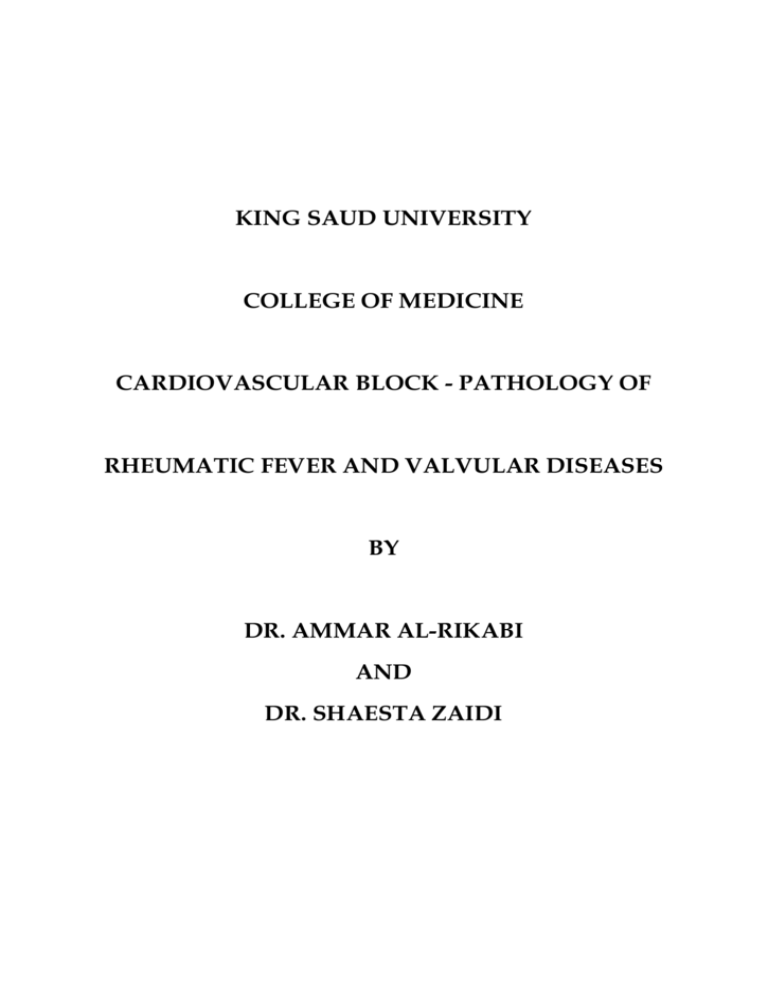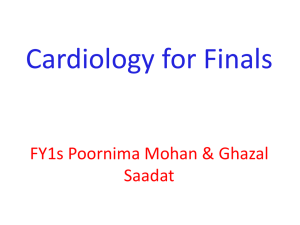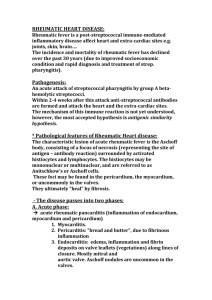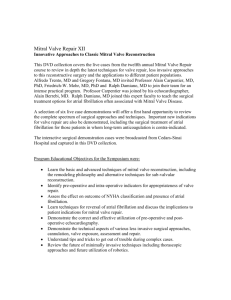CVS Hand-outs
advertisement

KING SAUD UNIVERSITY COLLEGE OF MEDICINE CARDIOVASCULAR BLOCK - PATHOLOGY OF RHEUMATIC FEVER AND VALVULAR DISEASES BY DR. AMMAR AL-RIKABI AND DR. SHAESTA ZAIDI 2 RHEUMATIC FEVER A. Definition. Rheumatic fever is a multisystem inflammatory disorder causing major cardiac manifestations and sequelae, most often affecting children between 5 and 15 years of age. (1) It is also characterized by transient mild migratory polyarthritis. (2) It usually occurs 1-4 weeks after an episode of tonsillitis or other throat infections caused by group A β-hemolytic streptococci. An elevated titer of antistreptolysin O (ASO) is evidence of a recent streptococcal infection. B. Etiology (1) Rheumatic fever is apparently of immunologic origin rather than a result of direct bacterial involvement; however, the precise nature of the immune mechanisms of injury remains unclear. It is postulated to occur as a result of streptococcal antigens that elicit (causes) an antibody response reactive to streptococcal organisms as well as to human antigens in the heart and other tissues. (2) The incidence has been remarkably reduced in the Western world in recent years but the disease is still very common in the Middle East and Saudi Arabia. C. Aschoff body (1) This is the classic lesion of rheumatic fever. (2) This is an area of focal interstitial myocardial inflammation that is characterized by fragmented collagen and fibrinoid material surrounded, by large cells (Anitschkow myocytes) and by occasional multinucleated giant cells (Aschoff cells). D. Other anatomic changes Characteristics include pancarditis, inflammation of the pericardium, myocardium and endocardium. (1) Pericarditis may result in pericardial, pleural or other serous effusions. (2) Myocarditis may lead to cardiac failure and is the cause of most deaths occurring during the early stages of acute rheumatic fever. (3) Endocarditis leads to valvular damage. (a) Rheumatic endocarditis usually occurs in areas subject to greatest hemodynamic stress, such as the points of valve closure and the posterior wall of the left atrium, resulting in the formation of the socalled MacCallum plaque. The mitral and aortic valves, which are 3 subjected to much greater pressure and turbulence, are more likely to be affected than are the tricuspid and pulmonary valves. (b) In the early stage, the valve leaflets are red and swollen, and tiny, warty, bead-like, rubbery vegetations (verrucae) form along the lines of closure of the valve leaflet. The small, firm verrucae of acute rheumatic fever are non-friable and are not a source of peripheral emboli. (c) As a consequence of fibrotic healing, the valves become thickened, fibrotic and deformed, often with fusion of valve cups as well as thickening of the chordate tendineae. Calcification is often prominent. These late sequelae, which often occur many years after the episode of rheumatic fever are grouped under the term rheumatic heart disease. (1) The mitral valve is the valve that is most frequently involved in rheumatic heart disease. (a) It is the only valve affected in almost 50% of cases. (b) It can be affected by stenosis with fish-mouth buttonhole deformity, insufficiency or a combination of both. (c) Mitral stenosis is marked by diastolic pressure higher in the left atrium than in the left ventricle. (2) The aortic valve is affected most often along with the mitral valve. It can be affected by stenosis or insufficiency. (3) The tricuspid valve is affected with the mitral valve and aortic valves (trivascular involvement) in approximately 5% of cases of rheumatic heart disease. (4) The pulmonary valve is rarely involved. E. Noncardiac manifestations of acute rheumatic fever (1) Fever, malaise and increased erythrocyte sedimentation rate (2) Joint involvement (a) Arthralgia – joint pain without clinically evident inflammation. (b) Arthritis – over joint inflammation presenting as painful, red, swollen, hot joints, usually involving larger joints, especially the knees, ankles, wrists and elbows. (3) Skin lesions including subcutaneous nodules, small painless swelling usually over bony prominences and erythema marginatum, a distinctive skin rash characteristic of rheumatic fever, often involving the trunk and extremities. (4) Central nervous system involvement, including Sydenham chorea, characterized by involuntary, purposeless muscular movements, and bizarre grimaces, as well as emotional disturbances. 4 Infective endocarditis. This bacterial or sometimes fungal, infection of the endocardium is marked by prominent involvement of the valvular surfaces. 1. 2. 3. General considerations (a) Characteristics include large, soft, friable, easily detached vegetations, consisting of fibrin and intermeshed inflammatory cells and bacteria. (b) Complications may include ulceration, often with perforation of the valve cups or rupture of one of the chordate tendinae. Classification (a) Acute endocarditis is caused by pathogens such as Staphylococcus aureus (50% of cases). This type of endocarditis is often secondary to infection occurring elsewhere in the body. (b) Subacute (bacterial) endocarditis, is caused by less virulent organisms such as Streptococcus viridians (more than 50% of cases). This type of endocarditis tends to occur in patients with congenital heart disease or presenting valvular heart disease, often of rheumatic origin. Clinical features (a) Valvular involvement (1) The mitral valve is most frequently involved. (2) The mitral valve along with the aortic valve is involved in about 40% of cases. (3) The tricuspid valve is involved in more than 50% of cases of endocarditis of intravenous drug users, in whom endocarditis is most often caused by staphylococcal infection. (b) Complications (1) Distal embolization occurs when vegetations fragment. (2) Embolization can occur almost anywhere in the body and can result in septic infarcts in the brain or in other organs. (3) The renal glomeruli may be site of focal glomerulonephritis (focal necrotizing glomerulitis) caused by immune complex disease or by septic emboli. Non-bacterial thrombotic endocarditis (marantic endocarditis) 1. 2. 3. This form of endocarditis associated with debilitating disorders, such as metastatic cancer and other wasting conditions. Characteristics include small, sterile fibrin deposits randomly arranged along the line of closure of the valve leaflets. The disease can result in peripheral embolization but unlike infective endocarditis, the emboli are sterile. 5 Endocarditis of the carcinoid syndrome 1. 2. 3. The cause is the secretory products of carcinoid tumors (vacoactive peptides and amines, especially serotonin (5-hydroxytrptamine). The valves on the left side of the heart are rarely involved, because serotonin and other carcinoid secretory products are detoxified in the lung. This form of endocarditis results in thickened endocardial plaques characteristically involving the mural endocardium or the valvular cusps of the right side of the heart. Valvular Heart Disease A. General considerations 1. Valvular heart disease occurs often as a late result of rheumatic fever. It may be secondary to various other inflammatory processes. 2. This disease may be congenital (like the Bicuspid aortic valve). 3. In addition, valvular heart disease can occur even with prosthetic cardiac valves, which are subject to physical deterioration or can be the site of thrombus formation or infectious endocarditis. They can also cause mechanical disruption of red blood cells, resulting in hemolytic anemia with schistocyte formation. B. Mitral valve 1. Prolapse is the most frequent valvular lesion in Western countries (rheumatic valve diseases are common in third world countries). Mitral valve prolapsed occurs in approximately 7% of the population, most often in young women. (a) Characteristics include myxoid degeneration of the ground substance of the valve (it can be a component of Marfan syndrome). (b) Results include stretching of the posterior mitral valve leaflet, producing a "floppy" cusp (parachute deformity) with prolapsed into the atrium during systole. These changes produce a characteristic systolic murmur with a midsystolic click. (c) The lesion is usually benign and asymptomatic but can result in mitral insufficiency. It is often associated with a variety of arrhythmias and predisposes to infective endocarditis. (d) Stenosis is almost always due to rheumatic heart disease. (e) Insufficiency is usually a result of rheumatic heart disease. It can also result from mitral valve prolapsed, infective endocarditis or damage to a 6 papillary muscle from myocardial infarction. It can be secondary to left ventricular dilation, with stretching of the mitral valve ring. C. Aortic valve. This valve, along with the mitral valve, is frequently involved in rheumatic heart disease and in infective endocarditis. 1. Stenosis often presents a calcific aortic stenosis caused by calcification of: (a) An otherwise normal aortic valve as an age-related degenerative change. This condition, called degenerative calcific aortic stenosis, is the most common cause of calcific aortic stenosis in person older thatn 60 years of age. This designation is used when the stenotic valve has three cusps. (b) A congenital bicuspid aortic valve. (c) A valve affected by rheumatic heart disease. In this case, scarring may be evidenced by fusion of the valve commissures. 2. Insufficiency can be caused by: (a) Nondissecting aortic aneurysm resulting from cystic medial necrosis. (b) Rheumatic heart disease usually in association with mitral valve disease. (c) Syphilitic (luetic) aortitis (now rare) with dilation of the aortic valve ring. D. Tricuspid valve. This valve is rarely involved along in rheumatic heart disease but may be involved together with the mitral and aortic valves. This trivalvular involvement accounts for approximately 50% of cases of rheumatic heart disease. The tricuspid valve may be involved in the carcinoid syndrome. E. Pulmonday valve. This valve is most commonly affected by congenital malformations occurring either alone or along with other congenital defects, such as in the tetralogy of Fallot. It is rarely involved in rheumatic heart disease, although it may be involved in the carcinoid syndrome.







